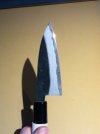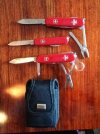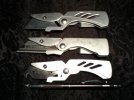Ballard_st,
Better to go extreme and then add a little bit of a steeper angle if there is some edge damage from intended use. To start factory stock and keep removing metal a little bit at a time is mind numbing and a waste of time.
Most factory / knife manufacturers are just freekin' nuts or they are erring so far on the safe side as to make the knife almost useless and more dangerous because of all the force required to actually cut something . . . I suppose so a moron doesn't damage the knife or . . . . hahahahha . . . get it sharp enough to actually cut them selves with it.
Here is a highly knowledgable custom knife maker who was trained in Japan (one of the few places one can buy a knife that actually is useful out of the box).
Listen to what he has to say. I don't agree with every thing in all his vids but this one is straight up CORRECT !
Here is a link to just tons of examples of the superiority of thin and shallow bevels for everyday pocket knife style cutting.
https://www.bladeforums.com/threads...ed-on-edge-retention-cutting-5-8-rope.793481/
Here you go; this is an example taken from the above link :
One knife with before and after edges.
the number after the steel type, 720 and 1120, are the number of cuts in good sized rope using a very controlled cutting force and parameters like that.
A factory stock Manix 2 in S110V
S110V - 720 - Manix 2 - 62 RC - .030" behind the edge
Same knife after some TLC grind grind.
S110V - 1120 - Manix 2 - 62 RC - Regrind to .005" behind the edge.




